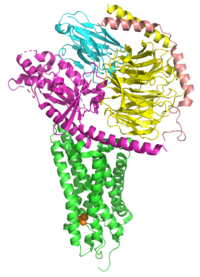
Photo from wikipedia
Procellariiform seabirds rely on their sense of smell for foraging and homing. Both genomes and transcriptomes yield important clues about how olfactory receptor (OR) subgenomes are shaped by natural and… Click to show full abstract
Procellariiform seabirds rely on their sense of smell for foraging and homing. Both genomes and transcriptomes yield important clues about how olfactory receptor (OR) subgenomes are shaped by natural and sexual selection, yet no transcriptomes have been made of any olfactory epithelium of any bird species thus far. Here we assembled a high-quality genome and nasal epithelium transcriptome of the Leach's storm-petrel (Oceanodroma leucorhoa) to extensively characterize their OR repertoire. Using a depth-of-coverage-assisted counting method, we estimated over 160 intact OR genes (∼500 including OR fragments). This method reveals the highest number of intact OR genes and the lowest proportion of pseudogenes compared to other waterbirds studied, and suggests that rates of OR gene duplication vary between major clades of birds, with particularly high rates in passerines. OR expression patterns reveal two OR genes (OR6-6 and OR5-11) highly expressed in adults, and four OR genes (OR14-14, OR14-12, OR10-2, and OR14-9) differentially expressed between age classes of storm-petrels. All four genes differentially expressed between age classes were more highly expressed in chicks compared to adults, suggesting that ORs genes may exhibit ontogenetic specializations. Three highly differentially expressed OR genes also had high copy number ratios, suggesting that expression variation may be linked to copy number in the genome. We provide better estimates of OR gene number by using a copy number-assisted counting method, and document ontogenetic changes in OR gene expression that may be linked to olfactory specialization. These results provide valuable insight into the expression, development, and macroevolution of olfaction in seabirds.
Journal Title: Genetics
Year Published: 2021
Link to full text (if available)
Share on Social Media: Sign Up to like & get
recommendations!